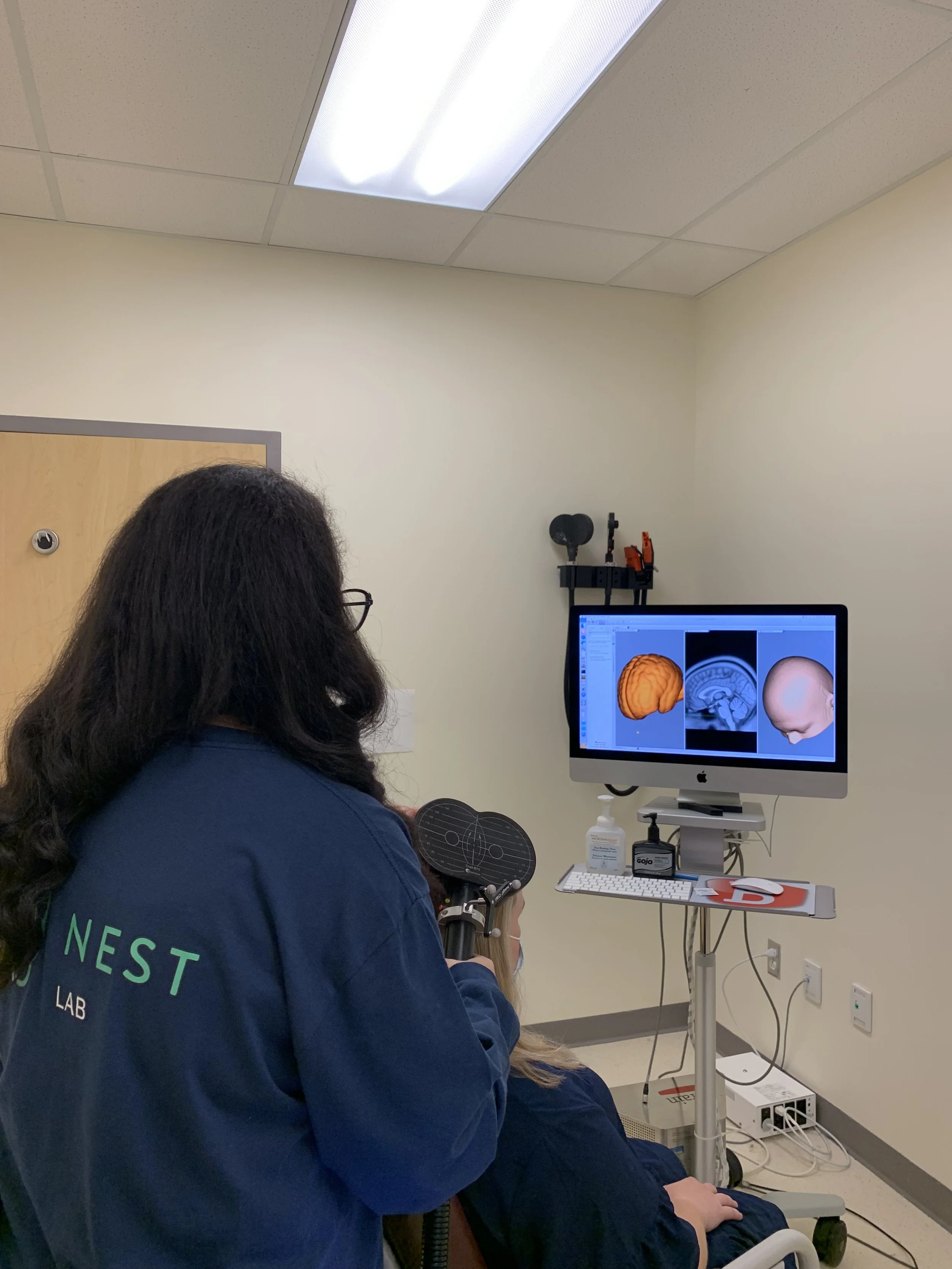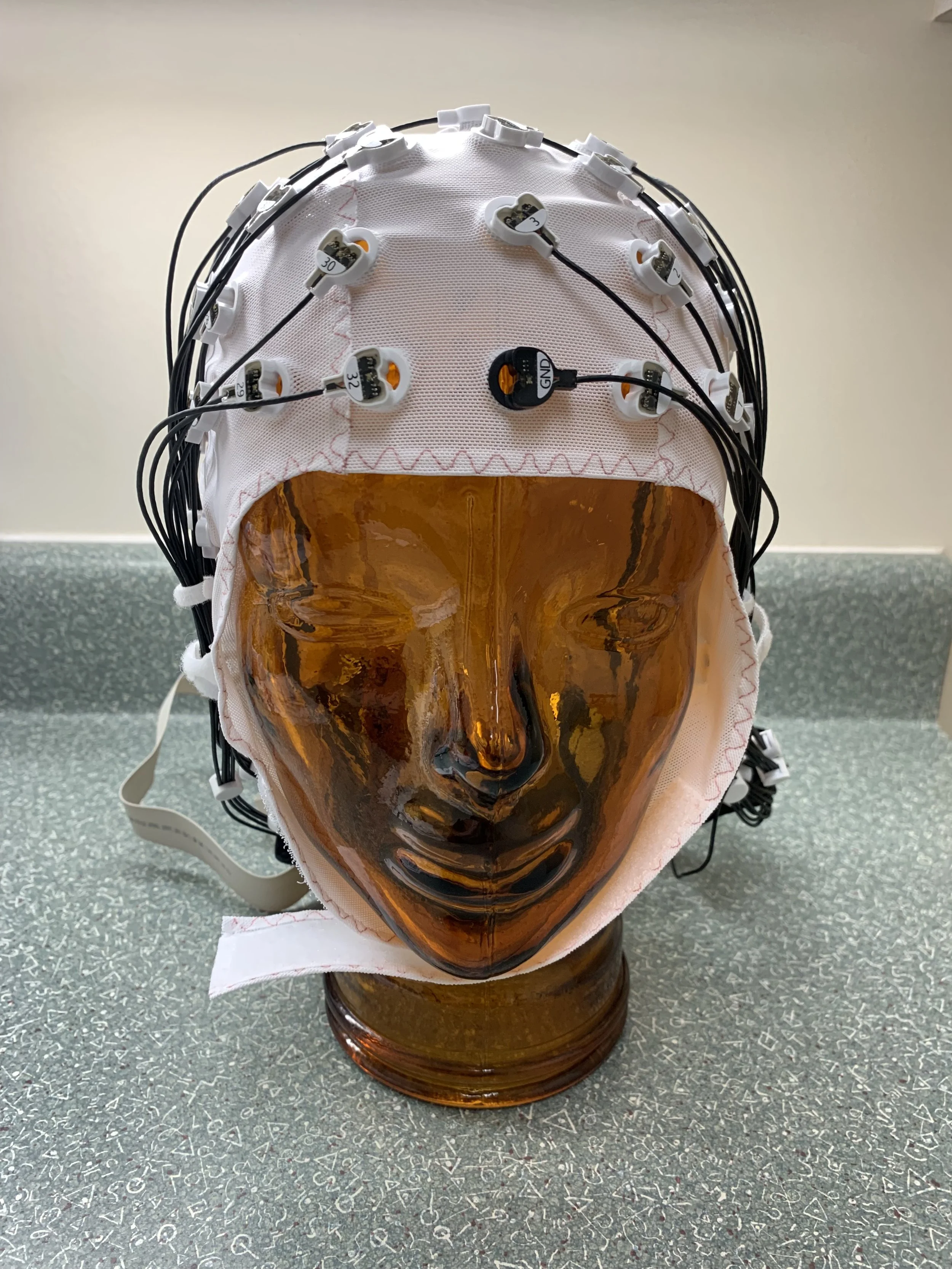
Learn More
What is Transcranial Magnetic Stimulation (TMS)?
Transcranial magnetic stimulation (TMS) is a non-invasive brain stimulation technique. TMS exerts its effects by placing an electromagnetic coil on the scalp while painlessly transmitting magnetic pulses through the coil.
What is theta burst stimulation?
Theta Burst Stimulation (TBS) is a new form of rTMS where the magnetic pulses are applied in patterns, called bursts. In TBS there are a burst of pulses per stimulation instead of just one pulse per stimulation. Due to this, the same amount of pulses can be applied in a shorter amount of time using TBS compared to rTMS.
There are two types of TBS; continuous TBS (cTBS) which reduces brain activity and intermittent TBS (iTBS) which increases brain activity.
TBS is used in our clinical trial as a treatment for depression. Patients with depression tend to have less brain activity on their left side compared to their right. For this reason, iTBS is used on their left side to increase brain activity, while cTBS is used on the right side of their brain to decrease brain activity.
What are the side effects of TMS?
TMS is a very safe procedure. However, there are some side effects associated with treatment. The most common side effects are: mild discomfort or pain at the stimulation site, tension headaches during stimulation or a slight, painless facial twitch when a pulse is delivered. Participants may also experience light-headedness or dizziness after treatment. All of these side effects are usually temporary and can be easily managed with rest or over the counter pain medication. 1-7% of individuals may experience less common side effects such as: fatigue, insomnia, anxiety or agitation, back or neck pain, vomiting, tinnitus, migraine aura or abnormal sensations. Even rarer, less than 1% of individuals may experience suicidal thinking, worsening of depressive symptoms or treatment-emergent mania. Although it is extremely rare (less than 0.1% of people), there is a risk of TMS inducing a seizure. Although, most cases of seizures occurring during TMS were reported before the introduction of safety guidelines in 1998. All side effects are closely monitored throughout and recorded after each TMS session.
What is Neuronavigation?
A neuronavigation system is a tool that can be used to precisely target a region of the brain. This system enables to reach specific brain targets either based on the MRI image of the person’s brain or on a standard human brain model.
How does Neuronavigation work?
First, a headband is placed over the person’s head. The headband and the coil are equipped with three small 3D trackers each. They look like three small grey balls. The navigation system also comes with an infrared camera that detects these 3D trackers. In this way, the computer can create a model with the exact position of the subject and the coil within the room of the lab. This is actually the same technique which is used for 3D movies!
After that, the research team member uses a pointer. A pointer is just like a pencil with 3D trackers on it, and that can be used to draw specific spots (landmarks) on the person’s brain model, by gently laying over their head for periods of one to two seconds per landmark. Then, the computer combines the specific shape of the person’s brain (obtained with landmarks) with the brain modelization (either obtained with MRI image or using a standard brain model).
Finally, once the brain model is calibrated depending on the person’s brain, the TMS operator can look at the 3D live animation, including the position of the coil, the target, the person’s brain, and precisely place the coil which interacts with the stimulation target.
What is TMS used for?
TMS can be used as a neuromodulatory tool to treat psychiatric illnesses (such as depression), traumatic brain injuries or symptoms associated with neurodegenerative disorders. Repetitive TMS (rTMS) is the specific form of TMS which allows for neuromodulation and is just how it sounds: TMS repeated continuously and more frequently.
TMS can also be used to assess neural function, such as the level of brain activity. When the Primary Motor Cortex (the area of the brain that controls movement) is stimulated, it produces a motor response called a Motor Evoked Potential (MEP). The level of brain activity can be quantified using the MEP. Research settings use TMS to assess neural function to better understand how TMS can affect the brain or to understand neurobiological characteristics of a certain illness.
TMS and Depression
TMS was approved for treatment of depression in Canada in 2002 but is currently only covered by provincial health plans in Saskatchewan, Quebec, and the Yukon. There are clinics in other provinces, however, patients must pay out of pocket for treatment, which can be expensive. We hope our clinical trial will lead to TMS coverage in Ontario, so more people will be able to benefit from this treatment.
What is Electroencephalography?
Electroencephalography (EEG) is a device that measures electrical activity in the brain. This is done by placing a cap with built-in electrodes on the head which tracks and records the electrical activity of the brain. The electrical activity is then amplified through an amplifier and sent to a computer which displays the activity in the form of brain waves. EEG’s are safe and painless but may make your hair a little messy because of gel used on the electrodes!
Transcranial Magnetic Stimulation and Electroencephalography
Together, transcranial magnetic stimulation and electroencephalography (TMS-EEG) allows the measurement of non-motor regions in the brain. TMS alone can measure activity in motor regions of the brain, but when paired with EEG, they can measure brain activity in non-motor regions as well. This allows researchers to look at the changes in brain activity in non-motor regions before and after an intervention, such as TBS. The measure of brain activity is called the TMS-evoked potential (TEP).





